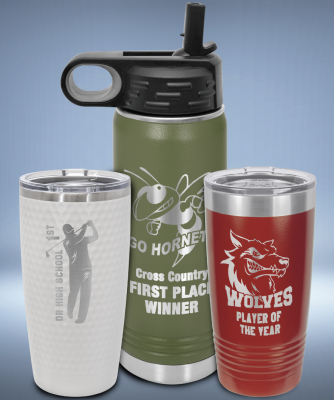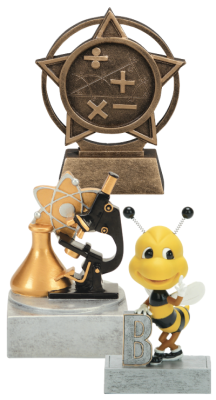Even before the pandemic, the awards market for youth sports was in flux. Once COVID-19 spread, school closures and canceled events severely dampened the market. “I hear so often that COVID-19 changed everything,” says Gregory Kolenut, national sales manager, Marco Awards Group. “That is also true in the youth sports awards market.”
A New Season of Awards
The pandemic threw a curveball to the sports awards market, but businesses have plenty of new—and traditional—opportunities to capitalize.
By: Caroline Heller
(Originally printed in the March/April 2023 issue of Insights.)
Even before the pandemic, the awards market for youth sports was in flux. Once COVID-19 spread, school closures and canceled events severely dampened the market. “I hear so often that COVID-19 changed everything,” says Gregory Kolenut, national sales manager, Marco Awards Group. “That is also true in the youth sports awards market.”
The pre-COVID youth sports market was strong for Peter Evangelista, owner of World Trophies Company, Inc. in Providence, Rhode Island. That changed quickly in March 2020. “We were getting calls from customers saying, ‘Our event is canceled; please cancel our order,’” Evangelista says. “Orders that were already completed and on the shelf were no longer picked up or wanted.”

Dan Messerschmidt, national sales director of JDS Industries, Inc., also saw the drastic effect of COVID on the sports awards market. “The closure of schools just decimated that segment of the business,” he says.
For many retailers, business was slow to return in 2021 but started to pick back up in 2022 with the return of large sports events and tournaments. “[In] 2023, it feels like things are kind of returning to normal,” Messerschmidt says. “The stands are full again when you go to high school football or basketball games.”

Awards courtesy of JDS
In the wake of all this change, there was and continues to be a push for less traditional trophies like rings, ribbons, apparel, medals and larger trophies, such as full-size footballs or basketballs. Nontraditional approaches include offering cheaper or reusable recognition products.
But in other areas, traditional trophies are not just back—they’re more popular than ever. Businesses looking to capitalize on youth sports awards will need to be flexible to meet changing customer preferences, creative and ready to meet customers at their preferred price points.
Change Ups
Although the pandemic had a huge impact on trophy sales, the consumer desire for nontraditional awards remained unchanged. “After the lockdowns lifted, we did see an interest in our customers for nontraditional award options,” Kolenut says. “Rings, belts and large resins were already gaining popularity before COVID-19, but even more so afterward.”
Messerschmidt and Evangelista saw the same trend. “The transition to nontraditional awards was already happening,” Messerschmidt says. “School systems had financial constraints, so they were already thinking of other options like medals.”
For Evangelista’s shop, he says, “In 2022, we were seeing more of a move toward medals because they tend to be less expensive and youth leagues still are struggling financially.”
In this vein, a trend worth exploring is offering reusable items. “Prior to the pandemic and even after it, people were saying, ‘A trophy is a nice award, but it doesn’t really do anything afterward,’” says Messerschmidt. “People started looking at reusable items like T-shirts and drinkware instead.”
It’s important to brand these products as reusable—especially for customers who might feel like a trophy just gathers dust. By calling products reusable, retailers can market them as an environmentally friendly option that is also cost-effective.
Traditional awards aren’t going away, though. “Interestingly, we’ve seen more of a move toward traditional trophies—a figure, a column and a marble base—versus resins,” says Evangelista. “Maybe leagues are wanting to go back to a more traditional look.”

Drinkware courtesy of JDS
Traditional trophies should always be an option for customers because there is an ebb and flow to what customers want—a kind of seasonal change that is similar to the seasonal cycle of sports events, Messerschmidt says. “Every year people try something different,” Messerschmidt says. “Sometimes after moving to nontraditional awards for a few years, people come back and want trophies, saying the kids are really looking for that kind of award again.”
New Gameplan
Lingering labor market shortages and supply chain issues forced some retailers to explore new routes to recognition production. “In general, for the awards industry, we have found that utilizing the materials we have and trying to customize them—like vector cutting acrylic or printing on acrylic—has given us more options,” Evangelista says. “Prior to COVID-19, we weren’t looking down this road because our supply chain was fine. But when the supply chain was affected, we had to get creative and work with what we had to make awards.”

Awards courtesy of PDU CAT
This led to the creation of more high-end awards for certain sports events, like golf tournaments. (Less so for youth sports.) “We started creating our own designs out of engraving plastic,” Evangelista says. “Because, at the end of the day, you still have to come up with product. If you can’t get certain supplies, you still have to meet customers’ needs.”
Marco Awards Group has also started getting creative in light of labor shortages. “With the tough labor market, retailers are looking for products that require less labor. For example, we sell pre-built trophies and economy and assembled cups that can be used in lieu of a traditional trophy,” Kolenut says. “Resins are always a good low-labor alternative, as well.”
Budget Crises
With inflation, prices have been on the rise. “There was so much fluctuation in wholesale prices and drastic increases, and, in 2022, some of the prices were adjusting every three months,” says Steve Rapchick, owner of All American Awards, Inc. in Charleston, South Carolina. For Rapchick, some prices have even doubled for certain products.
Budget cuts have affected schools in particular, Messerschmidt says. “It’s really kind of wild because during the pandemic there was all this stimulus money floating around, but there were no events,” Messerschmidt says. “Now the events are back, but the money is thinner.”

Awards courtesy of PDU CAT
Naturally, extreme price increases affect the customer directly, but Evangelista recommends being careful with pricing strategies, especially with youth sports leagues, which can be very cost-conscious. “Unlike corporations that have the means to absorb cost increases, youth leagues often don’t. Tournaments have very fixed budgets.” For example, a local pizza place that used to sponsor a youth league might not have the resources to do so yet.
“If there is a place my business is really watching our pricing carefully, I’d have to say it’s with the youth leagues,” Evangelista says.
Spring Forward
Retailers offer advice for the 2023 spring sports trophy season.
Order Early. Supply chain issues still haven’t gone away. Gregory Kolenut, national sales manager, Marco Awards, advises to order products as early as possible. “While conditions with ocean freight have improved, it’s always good to be aware of what your suppliers have in stock,” Kolenut says. “I believe that a retailer should always have the customer pick a second option to avoid any unforeseen issues getting the products.”
Don’t Assume a No-sale. Dan Messerschmidt, national sales director of JDS Industries, Inc., encourages retailers to be inquisitive about a potential customer’s fiscal health. “When you’ve dealt with schools or leagues before, sometimes it’s easy to assume that their budgets were cut,” Messerschmidt says. But that’s not always true from league to league or team to team. “There are programs and schools that have full budgets,” Messerschmidt says.
Don’t Forget Races. While soccer, baseball, basketball and football might be considered the more popular options for youth sports, retailers shouldn’t forget about races. There is a huge opportunity for medals, ribbons and trophies in this market. “We do a lot of races and runs,” Steve Rapchick, owner of All American Awards, Inc., says. One way to market yourself in this area is to make sure you have a lot of Google reviews. Rapchick’s business has more than 500 five-star reviews, and he says these have helped him expand into new markets, including races.
Quick Quote Turnarounds. Try to turnaround your quotes within 24-48 hours, says Peter Evangelista, owner of World Trophies Company, Inc. “It’s a very competitive market out there, and if you don’t get back to your customer within this time frame, then they are going to look elsewhere,” he says. “In the old days, you were only competing against the retailers in your area or region. But with the internet, customers are quick to get online and check prices elsewhere.”
Join Today and Invest in Your Business
When you become a member of the Awards and Personalization Association, you will receive access to the print and online editions of Insights Magazine along with many other valuable benefits. Explore how we can help you get connected with industry experts, increase your skills and knowledge through relevant learning opportunities, and save money with discounts for your business.
LEARN MORE